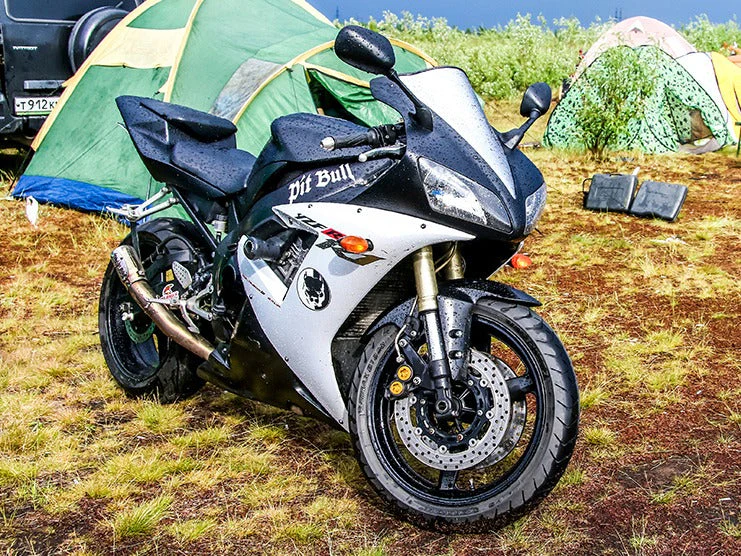Table of Content
Camping in the rain can be a bit unpleasant, but it doesn’t have to be dangerous or miserable if you know the right tips.
If you go on a motorcycle camping trip prepared for rain, you might even enjoy the experience, listening to the sound of rain falling onto your tent and watching a thunderstorm roll through, or the charming noise of rain beating against your tent.
You can check for rainy weather by looking at the weather forecast and preparing the appropriate equipment. If there is a chance of rain, it pays to be prepared just in case.
This article provides a list of 38 tips on how to go motorcycle camping in the rain.
1. What to Do When it Starts to Rain?
Listed below are the most reliable tips on how to go motorcycle camping in preparation for an incoming storm or in case of sudden rainfall.
1.1 Protect all non-waterproof gear
Bring a waterproof tarp in case of rain. After setting up a tarp, bring all non-waterproof gear underneath. If you don’t have a tarp, place the gear under cover to keep them dry, such as chairs, tables, washing equipment, or other electronic stuff, etc.
1.2 Lower the awning and tighten the ropes
To encourage runoff, make sure to lower the awning and tighten the ropes keeping your tent upright. This will prevent rain from pooling and keep water from dripping inside.
1.3 Check for water pooling
Check to see if any water is pooling in the awning or canopy. Allowing water to run off will prevent the tent’s fabric from being damaged.
1.4 Close all windows or doors of the camp
Close all the tent’s windows and doors to prevent rain from entering. However, make sure there is still ventilation.
1.5 Keep bedding and clothing away from tent walls
Try to move bedding and clothing away from the tent walls to prevent them from getting wet and reduce the noise of falling rain.
1.6 Keep wet gear outside the tent
Don’t bring wet gear inside the tent. Leave them outside to dry or put them inside waterproof bags if it currently raining.
1.7 Bring spare dry clothes
In case your clothes get wet while setting up your tent in the rain, make sure to have a spare set of dry clothes to change into.
1.8 Place containers underneath dripping water
If water is dripping inside your tent, place containers underneath to catch moisture and keep your tent’s floor dry. Near the high-traffic areas, try to reduce water build-up and flooding by doing this activity.
1.9 Protect firewood
If you plan to have a campfire, reserve a spot in your tent to stack your firewood. Otherwise, find a spot that offers cover and would remain relatively dry even while it is raining.
1.10 Sit back and relax
After setting up all your rain protection and moving your belongings into cover, sit back, relax, and enjoy the pitter-patter sound of falling rain.
2. Tips To Follow
Even if you check the weather forecast before going camping, it is not always accurate. Rainfall can still occur anywhere at any time without warning.
Many times, they have to face untoward situations for which they are not prepared or haven’t planned. So, here are tips you need to follow for safe motorcycle camping.
2.1 Things To Consider

Watch the Weather Forecast
Before leaving home, check the weather conditions on the route and at the destination in the days leading up to your departure.
Constantly Check the Weather
Make sure to constantly check the weather. You might see rain clouds coming your way, indicating the likelihood of rain. Or while camping near or in mountain areas, there is a very clear indication of rainy weather. So, start preparing by packing the appropriate riding gear and camping in a safe location.
Plan the Journey
Planning the journey beforehand will help you list all the things you need, familiarize yourself with the route and destination, and prepare backup plans in case of sudden rainfall. Moreover, planning the whole journey before leaving is necessary. But if it rains all of a sudden as there is no improvement in the weather, try making a new plan for the upcoming time.
2.2 Must Bring

Bring Plastic Bags
Bring large, cheap plastic bags or air-tight Ziploc bags that are easy to pack. If you get caught out in the rain, plastic bags will help keep their contents dry.
You can store wet gear, such as drenched clothes, soaking shoes, etc., inside plastic bags to keep your other items from getting wet. You can also use Ziplock bags to store food, electronics, etc.
Bring Newspapers
You can place dry newspapers inside your wet shoes to speed up the time it takes to dry.
Newspapers can also serve as kindling to help light a campfire if you have no dry firewood.
Appropriate Gear
Avoid wearing cotton trousers or t-shirts on rainy days. Appropriate gear for rainy days should include a raincoat and waterproof shirts, trousers, and caps.
It will protect you from getting soggy and wet. Also, if it is running, you can fix up the tent and go out for touring without worrying about rain.
Waterproofing Spray
While setting up camp, make sure to spray your non-waterproof items with waterproofing spray in advance before rain arrives. You can also apply waterproofing spray while it is raining.
Bring Long Waterproof Shoes
Though slighly expensive waterproof shoes or boots will help keep your feet dry when walking across soggy or muddy terrain.
Have Plenty of Spare Socks
On rainy days, prioritize covering your feet. While setting up a tent in the rain, wet socks will cause your feet to get cold. Make sure to bring plenty of spare, dry socks to change into.
Use Quick Dry Towels
Don’t bring heavy cotton towels. In general, thinner and lightweight towels tend to dry out faster. While buying a towel for camping, look for ones with low GSM (grams per square meter).
Bring Extra Blankets
If your camping destination often has rain, there might be a sharp drop in temperature at night. Just in case, bring extra blankets to stay warm.
Plan Your Meals
Not sure what to eat and bring camping? Make a checklist of the best foods to bring on a motorcycle camping trip.
Bring Hand Warmers
Pick up a hand warmer to keep your hands from freezing and your fingers becoming stiff.
Without hand warmers, it becomes more difficult to set up a tent in the rain. Other than these, if your hand and feet are warm, there are fewer chances of feeling cold.
2.3 Things To Do

Pitch the Tent on Dry Land
When picking a place to set up your tent, stay away from large bodies of water, muddy puddles, ditches, etc.
Keep the Tent High and Dry
While setting up your tent, don’t choose a low area like the bottom of a slope. Rather than set up camp in a relatively flat clearing, choose a high rise where water is unlikely to collect. Don’t give way to that temptation and place that is at the top of that small slope.
Put a Heavy-Duty Tarp Underneath Your Tent
While camping in the rain, groundwater can flood your tent. Most often, it starts to happen from below, not from above of camp. An easy way to prevent this is by placing a heavy-duty tarp underneath your tent. Make sure no part of the tarp sticks out underneath your tent.
Otherwise, the rain will travel along the exposed tarp and gather underneath your tent, soaking into your tent’s floor. Carefully fold any access trap under the tent to avoid any mishaps.
Position the Tent
Make sure to position the tent so it is facing the opposite direction of the wind. This will ensure less rain will enter through the windows and doors if they need to be opened for a moment.
So, if the door face is towards the wind, the rain will get it when you open the door. So, by following this method, at the time when you unzip your door, you will get less windswept rain inside.
Line the Inside of Your Tent
Even if you place a tarp underneath your tent, water can still enter due to heavy and extended rainfall. Adding an extra inner lining to your tent will help make it more waterproof. You can use thick plastic sheets that construction workers use.
Cut a piece of inner lining about six to seven inches wider than your tent’s diameter. Attach it to the inside of your tent to keep water out.
Place Another Tarp Above Your Tent
Place a large tarp at an angle above your tent to provide cover from rainfall. This is ideal if you plan to camp in the same spot for several days.
An overhanging tarp can also give you a place to hang wet clothes like a clothesline and a porch where you can take off your wet shoes.
In this way, you can save the inside of the tent from getting wet and mucky. Although if you have a large tarp, then it might be possible that you can get some spare for cooking!
Prep and Check Everything
Make sure all your belongings, including your camping gear, are waterproof. Check to see if any of your items need to be repaired. If you are going shopping for a new tent, then having a porch area will prove really handy for storing all wet items.
Tent Tension
Make sure the tent has enough tension when set up to ensure no water pools on the fly sheet. If a lot of water pools, the tent will eventually collapse on itself.
Don’t Go Too Far
Don’t go too far from the camp if it’s raining. Heavy rainfall and thick clouds can reduce visibility, making it easy to get lost in hilly or mountainous, got covered with rain in no time. Black clouds potent rain. So, if you see them make sure to not go miles away.
Ventilation
Your tent must be well-ventilated to prevent moisture from remaining trapped inside. If there is no ventilation, the smallest amount of water can cause your tent’s interior to become damp and cold.
Wrap Camp Gear Carefully
Pack your camp gear carefully. If you pack a damp tent or camp, the rainwater will cause damage to it. With time, it will start rusting, and camp will be of no use. Not only the camp but also the other gear demands the same precautions.
Stay Dry When Setting Up
Make sure to wear appropriate clothing while setting up your tent in the rain. If your clothes or shoes become drenched, it could result in all your belongings getting wet when you go inside.
Separate Wet and Dry Items
Make sure to keep all your wet and dry items separate from each other. Mixing your belongings together can cause a mess to prevent your wet items from drying off completely, and cause permanent damage to many of your items.
Take Off Shoes
If you don’t bring waterproof shoes, your standard shoes or boots will likely become wet. Before entering a tent, make sure to take your footwear off just outside.
If you are wearing waterproof shoes, then it might be possible your shoes are dry. You can go inside the tent only with dry items to keep all moisture out. This all prevents wet footprints in your living area.
Cook Outside, Eat Inside
Never cook inside your tent even if it is raining! Instead, set up a tarp above you to protect you and your food from the rain as you, cook. After you finish cooking outside, you can bring your food inside the tent to eat.
Be Careful on Wilderness Trails
If you are camping near a hiking area, be cautious when exploring wilderness trails. Keep your eyes peeled for slippery rocks, overflowing rivers, and other natural hazards.
Wear Appropriate Gear When Hiking in the Rain
If it is only lightly raining, you can go hiking if you are wearing the appropriate gear, including waterproof hiking boots and a raincoat.
| Note: Avoid hiking if there are warning signs indicating high windstorms, floods, thunder, or lightning. Stay on the trail and be careful not to slip. |
Make Sure to Dry All Wet Items
Make sure all your items are dry before packing them. When the rain stops, hang your wet clothes, sleeping bags, blankets, shoes, etc., and try to place them near the campfire to help them dry faster.
Bring a Raincoat
Even if there is a low chance of rain, make sure to bring a raincoat with you everywhere during your camping trip. A raincoat will keep you warm and dry, keeping your clothes from becoming soaked. But you can avoid this fate by immediately putting on a raincoat. Try to keep a raincoat with you everywhere you go.
2.4 Things To Avoid

Don’t Bring Cotton Clothing
Try not to bring cotton clothing with you as they take a long time or never fully dry even when it’s not raining. It is best to bring lightweight clothing made of nylon or other synthetic materials with moisture-wicking properties.
Don’t Touch the Sides of the Tent
Try to keep your belongings away from the sides of the tent. Any leaks along the walls of the tent could seep in and soak your things. If you do not implement this, you will end up with a soggy night.
Don’t Pack Wet Sleeping Bags
When picking a sleeping bag, try to get one made of waterproof materials. However, if your sleeping bag becomes wet, don’t pack it in your luggage bags. Instead, wait for the rain to stop and hang your sleeping bag to dry.
Don’t Bring Pets
It can be tricky to take a pet with you would have to worry about drying your pet’s hair and you might understand this if you do their grooming on your own. So, they don’t tend to be considerate about keeping them from going inside your tent while still wet.
2.5 For You

Enjoy the Rain
Last but not least, make sure to enjoy the journey. Surviving in minor or high rain is no more difficult if you follow the right tips and tricks. After setting up your campsite, sit back and relax!
Don’t Forget to Take Pictures
In the hassle of setting up and keeping all the things safe, don’t forget to take pictures of the weather, campsite, and environment to help you remember the trip. You can make memories by capturing images. Also, you can spend time playing games, reading books, and shooting vlogs if it rains a lot.
3. How to Protect Your Tent from Rain and High Winds?
You can protect your tent from rain and high winds by using a tarp.
3.1 What is a Tarp?
A tarpaulin, or tarp, is a plastic or nylon sheet used in place of a tent. Usually, it is set up with poles, ropes, and tent pegs. A tarp is durable and suited for rainy or sunny weather.
3.2 How to Hang a Tarp?
- Lay out the tarp, look at the covered areas, and visually measure whether the ropes are the correct length.
- Find two trees to tie the main high line across.
- After the rope is pulled taut between the two trees, begin sliding the tarp onto the line.
- Raise the ridge line rope (highest corner rope) and secure it as high as possible on one of the trees.
- Make sure the ridge line is pulled tight and secured.
- Now continue along, securing other corners and sides.
- If possible, slope the tarp down so it is facing the wind.
- Make sure the sides and corners are sloped to allow runoff.
- Make sure to tighten and re-secure the ropes regularly.
| Note: You can use a support pole or guide wires if needed. |
3.3 What’s the Best Knot to Use for Ropes?
There are a lot of ways to tie knots. Watch the video below for a better understanding.
If you find it difficult to tie a knot, here is the easiest way to set up the tarp without using knots.
4. Conclusion
Camping in the rain will be thrilling and joyful. Bring all necessary motorcycle accessories with you. If there is not enough space on the motorcycle for placing the gear, try choosing saddlebags, sissy bar bags, tour packs, and tank bags to store more stuff, or sissy bars with handles where you can mount bags. Have a safe journey!













Leave a comment
All comments are moderated before being published.
This site is protected by hCaptcha and the hCaptcha Privacy Policy and Terms of Service apply.